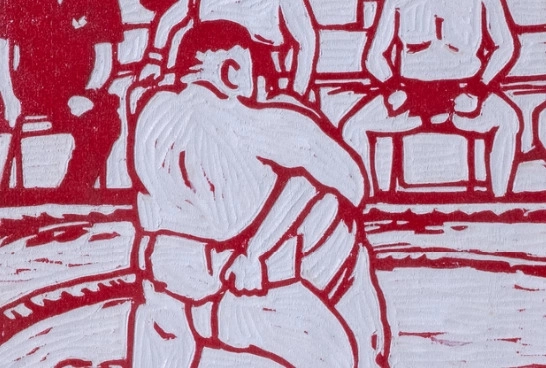Combining Western and Eastern culture, ancient and contemporary art, or depicting repulsive motifs in an attractive format. All that is characteristic of the rigorous woodcuts by Kenichi Yokono, whose work reveals the influence of surrealism as well as science fiction. The traditional themes permeate the artist's work in the form of Japanese heroes and sumo wrestlers; his depictions of urban life reveal cyclists and cheerleaders; and the strong influence of American pop culture can be observed in the production of woodcut skateboards and fingerboards.

The work of Japanese artist Kenichi Yokono draws on domestic traditions. His work is full of references to Japanese customs and rituals and to horror yōkai (word denoting scary, unexplainable phenomena in Japanese folklore). It is also influenced by pictures of ukiyo-e, traditional Japanese woodcarving popular in the 17th century. Those were the times when the city today known as Tokyo was becoming rich and even the lower social strata were able to enjoy otherwise difficult-to-reach entertainment such as theaters or Geisha services. This new lifestyle was called ukiyo, the "floating world". Its portrayal, which widely spread even among the less wealthy thanks to the color printing technique and the use of templates, was called ukiyo-e. Beautiful women, sumo wrestlers, landscapes, heroes and warriors are some of the characteristic motifs of this genre. All this inspired Yokono, too, whose work is, among other things, reminiscent of the tattoo art of ancient Japan.

Thematically, the artist also draws inspiration from mainstream phenomena of modern Japanese culture – primarily from manga, which he has been reading since childhood, and Japanese anime. By portraying the so-called cool japan motifs and alluding to iconic kawaii art, he addresses the themes of consumption and globalization. Cool japan is a brand found in the commercial rhetoric of his homeland, which aims to popularize typical elements of Japanese culture, such as anime or manga, which appeal to foreigners outside Japan due to their perceived coolness. On the other hand, kawaii art refers to the Japanese culture of cuteness represented by Hello Kitty or Pikachu. In Yokono's work, the cuteness meets, as he puts it, "the horror of everyday life".

Yokono's entire work is characterized by this effort to combine references to the past with contemporary modern expression. In his work, the artist fully utilizes his rich imagination and technical skills. Even though he works with the complex technique of woodcut, he does not use the wooden boards to create prints. Instead, he showcases them as works of art themselves, thus setting himself apart from traditional graphic technology. He then paints the raised surfaces of the woodcuts in cherry red and white.
The red refers to the dramatic manga images as well as the bloody city life, which he portrays in his woodcuts. The red-and-white combination also refers to the Japanese national flag, and red is also associated in Japanese tradition with heroic figures. The contrast between traditional symbolism and progressive Japanese culture is thus referred to also by his use of colors. As American critique Leah Ollman puts it: "Raw, vibrant and irreverent, the works have one foot in the pop-dominated present and the other in the tradition-bound past."

Yokono's work often reflects a desire to break free from the typical Japanese sensibility, as evidenced by the rough themes he portrays. His seemingly eye-pleasing and attractive works are in direct contradiction with the dark topics he depicts. This is one of the contrasts he utilizes in his work. According to Ollman, Yokono combines "upbeat graphic punch of cartoons with dark Expressionist urgency", playfulness with horror. The main theme of the Kenichi Yokono's woodcuts is the city and its corruption. He aims to challenge the way of life in the Japanese suburbs; his work is full of disturbingly sinister subtext and explicit images.

Like the contradiction between the old Japanese tradition and contemporary culture, his work also reflects the juxtaposition of the Eastern and Western environment. "[His work] steeped in both ukiyo-e painting traditions - à la Hokusai - and the uninhibited nature of American skate culture." The author's long-standing interest in skateboarding and surfing is evident, among other things, through the myriad of skateboards he has embellished. His interest in the Western art-historical canon is then also reflected by his references to Dutch still lifes and vanitas. These themes let him come to terms with the concept of transience and mortality, although his fascination with the fine line between life and death is typically Japanese.
Kenichi Yokono also makes fingerboards, miniature wooden skateboards with which you can do the same trick as on classic skateboard, except here you would use your fingers. Fingerboards first emerged in the 1970s, but it was not until the 1980s that the gained popularity in the US, in part due to their ability to simulate real skateboard tricks. Nowadays, fingerboarding has its own regular championship, among which the most popular are Fast Fingers and the EFC (European Fingerboard Cup), which also took place in the Czech Republic in 2009. In addition to the fingerboards themselves, Kenichi Yokono makes all accessories for this sport, including ramps, handrails, stairs and other obstacles to create one's own miniature skate park.

Kenichi Yokono was born in 1972 in Kanazawa, Japan, where he also studied art at Kanazawa College of Art. His solo exhibitions were to see in Tokyo, Los Angeles, Vienna and Amsterdam, and he has participated in many international group exhibitions. He lives and works in Kanazawa, Japan.
website: https://www.kenichi-yokono.com
Instagram: @yokonofbs





